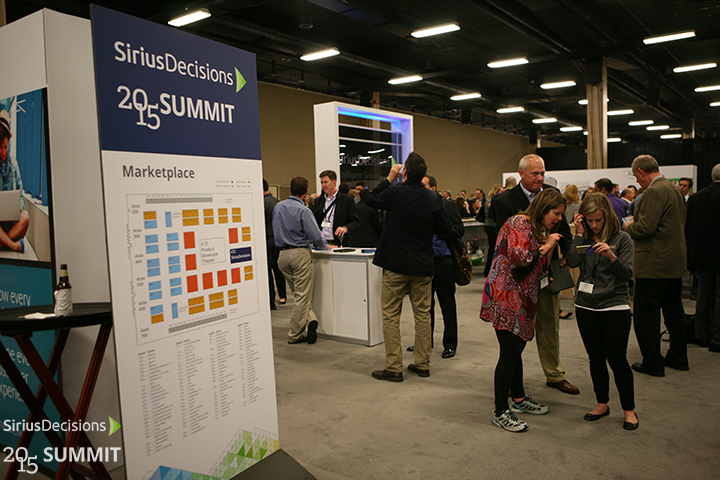Summit 2015 Highlights: Win the War for Talent Armed With Employee Lifecycle Marketing
- Attracting and retaining top talent is vital for fueling innovation and growth
- At Summit 2015 Erin Provey and Julie Ogilvie reported that employees are an important communications audience
- The Employee Lifecycle Framework provides a roadmap for optimizing each phase of the employee lifecycle
The war for talent affects all B2B companies. The reason is simple: Attracting and retaining top talent is vital for fueling innovation and growth.
 As Erin Provey and Julie Ogilvie of SiriusDecisions’ Strategic Communications Management service reported during their session on Employee Lifecycle Marketing at Summit 2015 in Nashville, employees are an increasingly important communications audience.
As Erin Provey and Julie Ogilvie of SiriusDecisions’ Strategic Communications Management service reported during their session on Employee Lifecycle Marketing at Summit 2015 in Nashville, employees are an increasingly important communications audience.
“Executives often talk a good game about the importance of employees as ‘our most valuable asset’ – but actual investment in and focus on employees is lacking,” said Erin. The good news, she added, is that when employees understand a company’s mission and feel an emotional connection to upholding it, there can be major gains all around – namely in dedication and productivity: “The organizations with the most skilled and loyal employees will be the ones that charge ahead.”
Julie then introduced the Employee Lifecycle Framework, which provides a roadmap for optimizing each phase of the employee lifecycle at a B2B organization. “A lifecycle approach recognizes that an employee’s relationship with the company changes over time,” Julie stated.
Within the framework, each of four lifecycle phases is charted, focusing on both the employee audience and the company’s responsibilities. Each phase also includes four elements of execution – including the definition of key objectives, how to interlock organizational functions (such as communications, HR and IT) in order to achieve those objectives, specific tactics to apply, and supporting technologies. A quick breakdown of the phases of the employee lifecycle is as follows:
- Attract/Selection. The objectives of this phase include positioning the company as a top employer and finding employees who are a good match for the company’s culture and specific job equirements. Some prospective employees will be in the market for a job while others will not be actively searching for a new position. It’s important to consider potential employees from several perspectives, including rational (“Is this job the best fit for me?), emotional (“Is a potential job change a wise move?”) and cultural (“Will I fit in?”) standpoint. The result is “Selection” by the employee, based on how the company fits his or her needs and expectations.
- Inform/Readiness. Once candidates become employees, the objective of this phase is to enable their success by providing the right information and insight. To optimize this phase, the company needs to allow employees to self-serve the information they require. This type of communications fosters confidence and minimizes disruption for both the new employee and the seasoned employees who otherwise would spend time helping the new employee find the necessary information.
- Inspire/Engagement. The objectives of this phase are to build employees’ understanding of the company’s mission and deepen their level of emotional commitment. For the company, a key part of this phase is helping employees get to know their colleagues better – to encourage them to become even more committed to the company’s success. The outcome of this phase is personal and professional pride for the employee in playing his or her part to help the company to achieve its goals.
- Celebrate/Advocacy. During this phase, employee lifecycle marketing reinforces company values through recognition, and employees become advocates of the company as a result of being motivated to achieve that recognition. “Employees dream of the moment they’ll cross the stage to shake the CEO’s hand,” Julie said. The win is two-fold: employees feel validated and appreciated, and the company gets an employee who wants to work harder for the greater good of the organization.
As Erin and Julie reviewed each of the phases, they shared compelling success stories of successful employee marketing. For example, as an illustration of the Attract/Selection phase, they highlighted the success of Vista Projects, an engineering firm in the highly competitive Canadian oil and gas industry, in leveraging social media combined with an engaging “Careers” page on its Web site. Vista Projects further leveraged LinkedIn by using current employees’ profile pages to help promote open positions at the company and extend its reach to relevant audiences. As a result of these efforts, Vista Projects’ candidate pipeline doubled while the number of interviews it conducted went down by half, because of the improved quality of potential employees.
What is your organization doing to optimize the employee lifecycle and win the war for talent? Join the conversation at #SDSummit or via the comments section below and let us know!